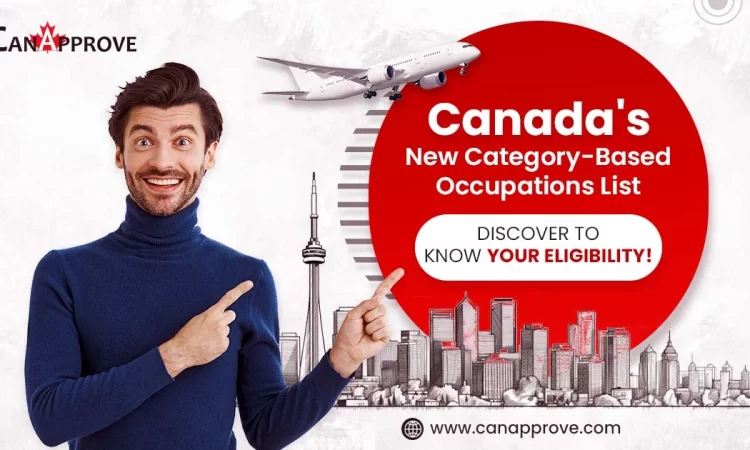The IRCC launched the concept of category-based draws to bring in skilled professionals to become permanent residents and fulfill labor shortages in domains such as STEM, healthcare, agriculture, trade, and other occupations. In invitation rounds for category-based occupations, Canada extends invitations to applicants in the Express Entry pool. These invitations are issued to candidates who fit into a particular category for the Canada skilled occupations list that the Minister has created to achieve a particular economic objective.
The Express Entry draw in Canada has targeted six categories this year:
?French Proficiency
?Healthcare Occupations
?STEM Occupations
?Trade Occupations
?Transport Occupations
?Agriculture and Agri-food Occupations
Category-based Selection – Requirements
Canada invites you to apply for permanent residence if you:
?Possess the ability to communicate in an official language (English/French).
?Have a work experience in the occupation specified under the occupations list.
?Meet the educational requirements.
To be eligible for permanent residency in Canada, you must meet the requirements set by the IRCC for category-based selection. While the IRCC holds these draws, candidates who meet the category requirements for the Canada skilled occupations list are ranked in the Express Entry pool, and the top-ranking candidates are invited to become PR in Canada.
Eligibility Criteria for Canada Skilled Occupations List in 2024
The Canada Express Entry Program uses the points-based system to assess applications. Finding applicants who have the best possibility of prospering after migrating to Canada is the primary goal of this method. The points scale rates you according to the following criteria and has a maximum score of 1200.
?Age
If you are between the ages of 18 and 35, you can get the most points. People who are older will receive fewer points.
?Education
Your minimum educational requirement must match Canada’s higher secondary education level. More points are awarded for higher educational qualifications.
?Work Experience
You must have worked for a minimum of a year to receive the required number of points. You will receive more points if you have worked for a longer period.
?Language Proficiency
To be qualified to apply and earn the required minimum points, you must have at least 6 bands on your IELTS score, which is equivalent to a CLB 7. More points are awarded for higher scores.
?Adaptability
If you have close relatives or family who now reside in Canada and can help you once you relocate, you can receive 10 points on the adaptability element. If your legal partner or spouse is prepared to go to Canada with you, you can also earn points in that regard.
?Arranged Employment
You are eligible for ten points if you have a legitimate job offer from a Canadian employer.
The eligibility requirement for the Express Entry program is 67 points out of 100. You will need to score at least 67 points under various eligibility criteria to apply for your PR visa. The following has the lowest Express Entry CRS score for various categories:
| Categories | CRS Score |
| French Proficiency | 375 |
| Healthcare Occupations | 431 |
| STEM Occupations | 481 |
| Trade Occupations | 388 |
| Transport Occupations | 435 |
| Agriculture and Agri-food Occupations | 354 |
Canada Skilled Occupations List in 2024
1️⃣Healthcare Occupations
For healthcare workers, immigration is a major source of supply. According to Statistics Canada’s most recent data on job openings, there were 153,000 open positions in the social assistance and healthcare sectors in April 2023. Out of all the employment sectors, this has the biggest number of open positions.

| Job Title | NOC Codes |
| Specialists in clinical and laboratory medicine | 31100 |
| Specialists in Surgery | 31101 |
| General Practitioners and Family Physicians | 31102 |
| Veterinarians | 31103 |
| Dentists | 31110 |
| Optometrists | 31111 |
| Audiologists and Speech-language Pathologists | 31112 |
| Dietitians and Nutritionists | 31121 |
| Psychologists | 31200 |
| Chiropractors | 31201 |
| Physiotherapists | 31202 |
| Occupational Therapists | 31203 |
| Kinesiologists and other Professional Occupations in Therapy and Assessment | 31204 |
| Other Professional Occupations in Health Diagnosing and Treating | 31209 |
| Nursing Coordinators and Supervisors | 31300 |
| Registered Nurses and Registered Psychiatric Nurses | 31301 |
| Nurse Practitioners | 31302 |
| Physician Assistants, Midwives, and Allied Health Professionals | 31303 |
| Licensed Practical Nurses | 32101 |
| Paramedical Occupations | 32102 |
| Respiratory Therapists, Clinical Perfusionists, and Cardiopulmonary Technologists | 32103 |
| Other Technical Occupations in Therapy and Assessment | 32109 |
| Medical Laboratory Technologists | 32120 |
| Medical Radiation Technologists | 32121 |
| Medical Sonographers | 32122 |
| Traditional Chinese Medicine Practitioners and Acupuncturists | 32200 |
| Massage Therapists | 32201 |
| Other Practitioners of Natural Healing | 32209 |
| Medical Laboratory Assistants and Related Technical Occupations | 33101 |
| Nurse Aides, Orderlies, and Patient Service Associates | 33102 |
| Pharmacy Technical Assistants and Pharmacy Assistants | 33103 |
| Other Assisting Occupations in Support of Health Services | 33109 |
| Therapists in Counseling and Related Specialized Therapies | 41301 |
| Educational Counsellors | 41320 |
| Instructors of Persons with Disabilities | 42203 |
2️⃣STEM Occupations
The foundation of Canada’s developing economy is the STEM fields. There were an astounding 56,915 job openings in the Professional, Scientific, and Technical Services category alone in the fourth quarter of 2022. Leading the way in meeting this demand are British Columbia, Ontario, and Quebec, which highlight their innovative and progressive sectors.

| Job Title | NOC Codes |
| Architects | 21200 |
| Architecture and Science Managers | 20011 |
| Business System Specialists | 21221 |
| Civil Engineers | 21300 |
| Computer and Information Systems Managers | 20012 |
| Computer Engineers (except software Engineers and Designers) | 21311 |
| Computer Systems Developers and Programmers | 21230 |
| Cybersecurity Specialists | 21220 |
| Data Scientists | 21211 |
| Database Analysts and Data Administrators | 21223 |
| Electrical and Electronics Engineers | 21310 |
| Engineering Managers | 20010 |
| Industrial and Manufacturing Engineers | 21321 |
| Information Systems Specialists | 21222 |
| Land Surveyors | 21203 |
| Landscape Architects | 21201 |
| Mathematicians, Statisticians, and Actuaries | 21210 |
| Metallurgical an Materials Engineers | 21322 |
| Natural and Applied Science Policy Researchers, Consultants, and Program Officers | 41400 |
| Software Developers and Programmers | 21232 |
| Software Engineers and Designers | 21231 |
| Urban and Land Use Planners | 21202 |
| Web Designers | 21233 |
| Web Developers and Programmers | 21234 |
3️⃣Agriculture and Agri-food Occupations
The percentage of unfilled positions in the Agriculture, Forestry, Fishing, and Hunting category at the end of 2022 was 10,535, or 3.9%.

| Job Title | 2021 NOC Code | 2021 TEER Category |
| Contractors and Supervisors, Landscaping, grounds maintenance and horticulture services | 82031 | 2 |
| Agricultural Service Contractors and Farm Supervisors | 82030 | 2 |
| Butchers – Retail and Wholesale | 632013 | 3 |
4️⃣Transport Occupations
Collectively, a survey suggests that, from now until 2025, Canada would need to hire about 17,000 extra truck drivers yearly to keep up with the labor market shortages, despite reported predictions and statistics varying among sources.

| Job Title | 2021 NOC Code | 2021 TEER Category |
| Aircraft Assemblers and Aircraft Assembly Inspectors | 93200 | 3 |
| Transport Truck Drivers | 73300 | 3 |
| Railway Traffic Controllers and Marine Traffic Regulators | 72604 | 2 |
| Engineer Officers, Water Transport | 72603 | 2 |
| Deck Officers, Water Transport | 72602 | 2 |
| Air Traffic Controllers and Related Occupations | 72601 | 2 |
| Air Pilots, Flight Engineers, and Flying Instructors | 72600 | 2 |
| Aircraft Mechanics and Aircraft Inspectors | 72404 | 2 |
| Railway Carmen/Women | 72403 | 2 |
| Managers in Transportation | 70020 | 0 |
5️⃣Trade Occupations
Trade occupations are still in high demand in Canada because they are essential to so many different sectors of the national economy. Buildings, infrastructure, and residences all require skilled craftspeople like plumbers, electricians, and carpenters. These trades will always be in demand due to population growth and ongoing development projects.

| Job Title | NOC Codes |
| Residential and Commercial Installers and Servicers | 73200 |
| Elevator Constructors and Mechanics | 72406 |
| Machine Fitters | 72405 |
| Heating, Refrigeration, and Air Conditioning Mechanics | 72402 |
| Construction Millwrights and Industrial Mechanics | 72400 |
| Carpenters | 72310 |
| Plumbers | 72300 |
| Electricians (Except Industrial and Power Systems) | 72200 |
| Welders and Related Machine Operators | 72016 |
| Contractors and Supervisors, Other Construction Trades, Installers, Repairers and Servicers | 72014 |
Wrap-Up
IRCC states that these new categories were chosen based on labor market information. It also includes projections and input from stakeholders across the country. These categories aim at supporting and developing economic concerns in Canada. If you’re one of these occupations, you have a sea of opportunities that awaits you in Canada. Begin your abroad journey by getting in touch with our Canada immigration consultants at CanApprove! We’d love to hear from you!
FAQs
- What occupations are in shortage in Canada?
Jobe’s roles in the Healthcare sector remain in demand across provinces in Canada. Labor markets particularly lack nursing occupations in Canada.
- Which job is booming in Canada?
In prominent areas including sales, health care, and community services, jobs such as assistant nurse, customer service representative, project manager, pharmacy technician, and data analyst are in high demand in Canada. Our lives advancement is determined by our careers.
- What is the minimum score for Canada Express Entry?
You can be eligible for the Federal Skilled Worker Program if your score is 67 or above. You can then add a profile to the Express Entry database. If you score lower than 67 points, you won’t qualify for the program.



 The demand for RNs and NPs in Canada is consistently high due to various factors such as an aging population, an increase in chronic health conditions, and a growing need for healthcare services in rural and underserved areas.
The demand for RNs and NPs in Canada is consistently high due to various factors such as an aging population, an increase in chronic health conditions, and a growing need for healthcare services in rural and underserved areas. The demand for medical practitioners, including physicians and specialists, varies across different provinces in Canada due to factors such as population size, demographic trends, healthcare needs, and regional disparities in access to medical services.
The demand for medical practitioners, including physicians and specialists, varies across different provinces in Canada due to factors such as population size, demographic trends, healthcare needs, and regional disparities in access to medical services. For international pharmacists seeking to practice in Canada, the credential assessment and licensing process involves several steps:
For international pharmacists seeking to practice in Canada, the credential assessment and licensing process involves several steps: The Express Entry process involves several steps:
The Express Entry process involves several steps: 